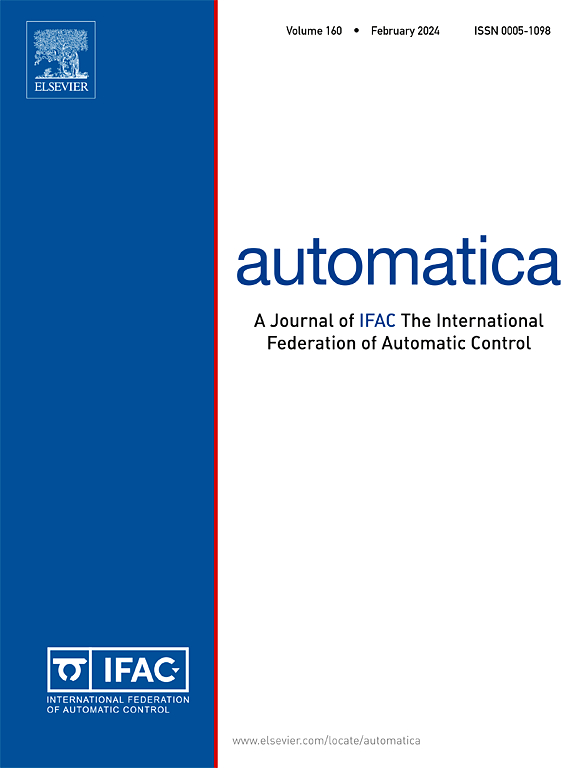一种带衰落测量的多目标状态估计分层方法
IF 5.9
2区 计算机科学
Q1 AUTOMATION & CONTROL SYSTEMS
引用次数: 0
摘要
由于外部干扰和噪声、参数变化和运行条件的变化,工程系统通常会出现多个动态结构。本文提出了一种新的多动态模态离散系统状态估计的层次结构,并将其应用于有衰落观测的多目标设计。首先,建立了一种分层估计结构,用于选择任意分支的估计,以实现与对象动态结构相关的各种估计之间的自主切换;讨论了Luenberger形式估计量和一般动态估计量,以及相应的选择算子。其次,在此基础上,研究了随机衰落信道上的鲁棒最优状态估计问题,其中采用了一种具有两个估计量的双层方案,分别处理设备失效和标称运行条件。对于前一种情况,期望估计量在非零和纳什博弈框架内表征,能够保证对故障的鲁棒性,并在最坏故障下最小化估计误差。利用一组交叉耦合增广修正代数Riccati方程(MAREs)推导了由最优增益和最坏故障信号组成的纳什均衡策略,并对均方稳定性进行了严格的分析。对于标称条件,通过MARE构造了一个具有衰落测量的平稳卡尔曼滤波器。第三,将结果进一步扩展到时变情况下,解决了存在数据丢失的估计问题,其中两个估计器都与确认同步,并给出了相应的设计方法。最后通过一个算例说明了所提方法的有效性。本文章由计算机程序翻译,如有差异,请以英文原文为准。
A hierarchical scheme for multi-objective state estimation with fading measurements
Engineering systems normally appear multiple dynamical structures due to external disturbances and noises, parameter variations, and varying operating conditions. In this paper, we present a novel hierarchical architecture for state estimation of discrete-time systems with multiple dynamical modes, and apply such scheme to the multi-objective design subject to fading observations. Firstly, a hierarchical estimation structure is established for choosing estimates of arbitrary branch to achieve autonomous switch among diverse estimators related to variant dynamical structures of the plant. Both Luenberger form estimators and general dynamical estimators, together with corresponding selecting operators, are explored. Secondly, based on the developed form, the problem of robust optimal state estimation over stochastic fading channels is studied, where a double-layer scheme with two estimators, dealing with the plant failure and the nominal operating condition, is adopted. For the former case, the desired estimator, characterized within the non-zero sum Nash game framework, is capable of ensuring robustness against faults and minimizing the estimation error under the worst fault. The resulting Nash equilibrium strategies, consisting of the optimal gain and the worst-case fault signal, are derived by a set of cross-coupled augmented modified algebraic Riccati equations (MAREs), and a rigorous analysis of mean square stability is also provided. For the nominal condition, a stationary Kalman filter with fading measurements is constructed via an MARE. Thirdly, the results are further extended to the time-varying case for addressing the estimation problem in the presence of data loss, where the two estimators are both synchronized with the acknowledgment, and the resulting design approaches are also provided. Finally, an example is included to show the effectiveness of the present methods.
求助全文
通过发布文献求助,成功后即可免费获取论文全文。
去求助
来源期刊

Automatica
工程技术-工程:电子与电气
CiteScore
10.70
自引率
7.80%
发文量
617
审稿时长
5 months
期刊介绍:
Automatica is a leading archival publication in the field of systems and control. The field encompasses today a broad set of areas and topics, and is thriving not only within itself but also in terms of its impact on other fields, such as communications, computers, biology, energy and economics. Since its inception in 1963, Automatica has kept abreast with the evolution of the field over the years, and has emerged as a leading publication driving the trends in the field.
After being founded in 1963, Automatica became a journal of the International Federation of Automatic Control (IFAC) in 1969. It features a characteristic blend of theoretical and applied papers of archival, lasting value, reporting cutting edge research results by authors across the globe. It features articles in distinct categories, including regular, brief and survey papers, technical communiqués, correspondence items, as well as reviews on published books of interest to the readership. It occasionally publishes special issues on emerging new topics or established mature topics of interest to a broad audience.
Automatica solicits original high-quality contributions in all the categories listed above, and in all areas of systems and control interpreted in a broad sense and evolving constantly. They may be submitted directly to a subject editor or to the Editor-in-Chief if not sure about the subject area. Editorial procedures in place assure careful, fair, and prompt handling of all submitted articles. Accepted papers appear in the journal in the shortest time feasible given production time constraints.
 求助内容:
求助内容: 应助结果提醒方式:
应助结果提醒方式:


